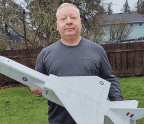AILERON/RUDDER MIXING EXPLAINED

As the name implies, adverse yaw is an adverse or unfavorable condition that, among other things, delays achieving solo abilities. Traditionally, until his or her skills improve, struggling and committing to many hours of practice before soloing has been the assumed burden of a student pilot. Unknowingly and unnecessarily, novices have been fighting the additional challenge of flying with adverse yaw. Indeed, novice pilots have always assumed the lack of correlation between their control inputs/intentions and the response of the plane to be due to wind (or the need for more practice), when in fact adverse yaw has been a big factor!
This article details the practice of using aileron/rudder transmitter mixing to eliminate adverse yaw, i.e., the inherent opposite yaw or skid that is especially pronounced during aileron deflections on flat-bottom-wing aircraft, such as those used for primary flight training. It’s probably safe to say that most of the people reading this learned to fly at the side of a recreational flier/instructor with little preflight preparation. As a result, most pilots are conditioned to “react” to what the airplane does, as opposed to having a plan and pro-actively controlling
You’re reading a preview, subscribe to read more.
Start your free 30 days



